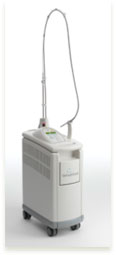What are the different types of dental lasers?
A wide selection of dental lasers with variable characteristics

Compact,
polyvalent
Erbium laser with fiber The active medium (CO2, Nd:YAG, Erbium:YAG or diode), source of the light beam, gives the name to the type of lasers. To each type of active medium corresponds a given wavelength.
1. Erbium lasers (Hard and Soft Tissue Lasers)    
Dental Erbium lasers came to the market at the end of the 1990's.
They are the most advanced and versatile dental lasers. They enable dentists to perform numerous clinical procedures on both hard tissues and soft tissues in the oral cavity. They are the optimal dental lasers for effective, precise and minimally invasive ablation of dental tissues.

Treatment tip
Curved treatment tip The wavelength emitted by these lasers allows a maximal absorption of the light by the water content of oral tissues. Dental Erbium lasers not only produce minimal heat, but a built-in water spray also cools down target tissue. Thus virtually no heat is generated in the tissue leading to minimal pain and quicker healing process.
The light emitted by the laser is transmitted to the tissue either through an optical delivery fiber, or through an articulated arm. The most advanced Erbium lasers use a fiber and small removable treatment tips allowing an optimal visual access in the mouth. Dental Erbium lasers with articulated arm are usually less user friendly.
2. Thermal Lasers (Soft Tissue Lasers)
Soft Tissue lasers transform light energy into heat to cut tissues. None of them use a water spray to cool down tissues which makes these dental lasers more painful.

Transportable diode laser
- Diodes     : Diodes are the most recent dental thermal lasers. Diodes use semi-conductors that convert the electrical energy into light energy. : Diodes are the most recent dental thermal lasers. Diodes use semi-conductors that convert the electrical energy into light energy.
Diodes are compact, transportable, and affordable. They represent a good entry point into laser dentistry.
- Nd:YAG and Nd:YAP lasers (usually named "YAG" and "YAP" lasers)   
"YAG" and "YAP" lasers are old and are not always appropriate for dentistry. Nd:YAG lasers are more commonly used in dermatology rather in dentistry.
Dental YAP and YAG lasers heat and penetrate the tissue deeply. It has been known that when the lasers have been used incorrectly, this can lead to severe lesions, in particular necrosis or inflammation of the dental nerves (tooth devitalization).
For all of these reasons, the lasers (especially the YAP laser) have not always held a strong reputation among the dental community.
These dental lasers are mainly used in periodontics and endodontics.
- CO2 lasers    
Coming from the industrial lasers, CO2 lasers were the first dental lasers to penetrate the market in the 1980's. These gas lasers are far from precise as there should be no contact with the tissue. They are mainly used in soft tissue surgery allowing fast tissue incisions with minimal bleeding. The use of these dental lasers requires high expertise to avoid excessive carbonizations. |